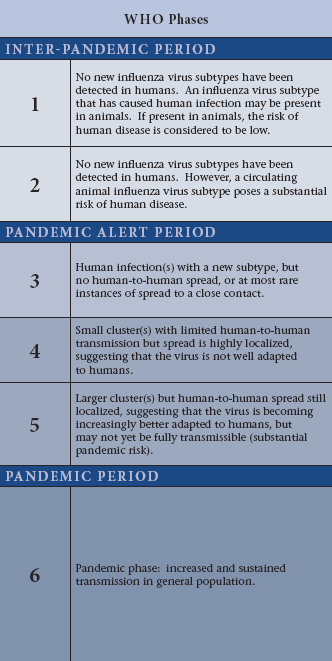What do you mean pandemic?
Despite the cessation of ‘pig kissing frolicks‘ it looks as though the WHO will eventually declare that 2009 H1N1 influenza A (‘swine flu’) has reached pandemic proportions (phase 6).
What does this mean?
A phase 6 influenza pandemic means that the virus is now spreading between people across countries in a sustained fashion and will have a global distribution (although not necessarily affecting every country).
But doesn’t seasonal influenza spread globally anyway?
The other part of the definition of an influenza pandemic is that the causative agent must be a new strain of virus. Thus seasonal influenza is not called a pandemic because it involves strains of influenza A that we have seen before, even though it spreads worldwide. Conversely, the H5N1 avian influenza A that we’ve been so worried about in recent years was a new strain, but thus far hasn’t been able to transmit from person to person efficiently enough to affect people globally.
Note that the definition of pandemic does not refer in any way to the severity of illness affecting the infected individuals.
In general, a pandemic might be expected to cause more severe illness because affected people will lack preexisting immunity to the new strain. For this reason reports of deaths in young (presumably) healthy people in Mexico from H1N1 are concerning, and such deaths were indeed a notable feature of the devastating 1918 Spanish influenza pandemic that followed World War 1 killing 50 million people. However, thus far, H1N1 influenza cases that have occurred outside of Mexico do not seem to be any more severe than seasonal influenza (which kills 500,000 people a year!). The very young, very old, and immuno-compromised are, as always, at greatest risk. Nevertheless, the virulence of H1N1 influenza remains poorly defined and has the potential to increase so we must remain vigilent.
Life in the Fast Lane ‘swine flu’ posts
- Lessons from 1918
- Swine Flu in ICU
- What do you mean pandemic?
- H1 N1 DON’T PANIC!
- The Two Faces of Swine Flu
Chris is an Intensivist and ECMO specialist at the Alfred ICU in Melbourne. He is also a Clinical Adjunct Associate Professor at Monash University. He is a co-founder of the Australia and New Zealand Clinician Educator Network (ANZCEN) and is the Lead for the ANZCEN Clinician Educator Incubator programme. He is on the Board of Directors for the Intensive Care Foundation and is a First Part Examiner for the College of Intensive Care Medicine. He is an internationally recognised Clinician Educator with a passion for helping clinicians learn and for improving the clinical performance of individuals and collectives.
After finishing his medical degree at the University of Auckland, he continued post-graduate training in New Zealand as well as Australia’s Northern Territory, Perth and Melbourne. He has completed fellowship training in both intensive care medicine and emergency medicine, as well as post-graduate training in biochemistry, clinical toxicology, clinical epidemiology, and health professional education.
He is actively involved in in using translational simulation to improve patient care and the design of processes and systems at Alfred Health. He coordinates the Alfred ICU’s education and simulation programmes and runs the unit’s education website, INTENSIVE. He created the ‘Critically Ill Airway’ course and teaches on numerous courses around the world. He is one of the founders of the FOAM movement (Free Open-Access Medical education) and is co-creator of litfl.com, the RAGE podcast, the Resuscitology course, and the SMACC conference.
His one great achievement is being the father of three amazing children.
On Twitter, he is @precordialthump.
| INTENSIVE | RAGE | Resuscitology | SMACC

